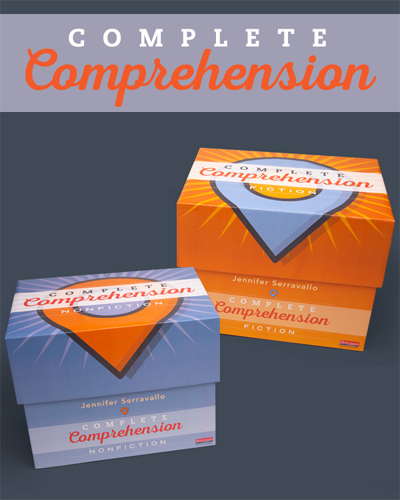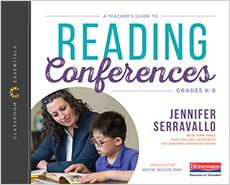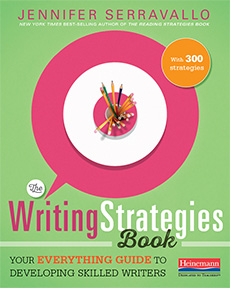Testimonials
GENERAL
How Jennifer Serravallo sparked a change in my teaching
—Justin Collard, 5th grade teacher
It all started with one connection, a spark, the smallest of “aha” moments. I had finally discovered a story that matched the daily struggles that I was seeing in my classroom. As a 5th grade ELA teacher, I have students that range from reading on level J to level W, and I felt like I had no idea how to meet each student where they were in a meaningful way. I had grown weary with the limited growth yielded by my current teaching practices, yet this spark of inspiration developed into a wildfire of student successes—successes I had assumed were rare, only existing in books about teaching. The story that sparked my teaching overhaul was Vanessa’s story as featured in Jennifer Serravallo’s Understanding Texts and Readers.
COMPLETE COMPREHENSION

Conversations went from What am I going to teach next to I need to make sure students have access to these skills because this is what they’re ready for.
—Danielle, Director of Elementary Education
We never saw a resource like this which actually laid out in rubric form indicators of how a child would move through different reading levels.
—Laurie, Literacy Coach
I have all the data I need in terms of kids and them being excited about their reading and the light bulbs that go off as they read.
—Cliff, Elementary Principal
I wasn’t buying in right away, but once I saw the wealth of information that I got back, I was totally sold.
—Linda, 5th Grade Teacher
TEACHER’S GUIDE TO READING CONFERENCES

"If you are a reading teacher, a curriculum coach, or a school leader, order a copy of A Teacher’s Guide to Reading Conferences right now. It is a must-have resource for anyone who wants to up their teaching and learning game during independent reading time. The entire book is dedicated to helping teachers have quality conferences with readers."
—Rita Platt
Read the entire review at Middleweb
UNDERSTANDING TEXTS & READERS

If you teach in a self-contained elementary school classroom, are a reading specialist or interventionist, teach special education, are a junior high or high school English language arts teacher, or a content teacher charged with integrating disciplinary literacy, you should read this book.
—Rita Platt
https://www.middleweb.com/39693/pair-just-right-texts-and-reading-strategies/
Simply amazing! Jennifer Serravallo outdid herself – again! Her new book, Understanding Texts & Readers: Responsive Comprehension Instruction with Leveled Texts, is one of the most teacher friendly books that I have read.
—Linda Biondi
https://www.middleweb.com/39448/building-comprehension-using-leveled-texts/
When I ask teachers in the future whose shoulders they're standing on after a particular lesson, I'm sure to hear Seravallo's name. And they'll be no doubt that she truly deserves the credit.
—Third and Rosedale
http://thirdandrosedale.blogspot.com/2018/09/standing-on-shoulders-of-giants.html
Where has this book been all my life? Understanding Texts and Readers feels like it pulls together everything Serravallo has been working on for the past several years into one clear, very understandable book. It’s definitely worth a book study with a team of teachers or even an entire school.
—Heather at Coaching, Teaching, Always Learning
http://coachingteachingalwayslearning.blogspot.com/2018/09/book-review-understanding-texts-and.html?spref=tw
Jennifer Serravallo has expanded on the research of many of the pillars of literacy when writing this book (Fountas & Pinnell are referenced often). But in true Serravallo fashion, she has approached a complex topic and made it teacher friendly, accessible, and has created a resource that teachers can turn to time and time again to help them better meet the needs of their students.
—Stacey Taylor, Teaching from the Left
https://teachingfromtheleft.blogspot.com/2018/09/review-of-understanding-texts-and.html
I hope all teachers of readers will get together with this book and have conversations that help us re-imagine the uses of leveled text, re-ignite a passion for teaching readers, and most of all re-engage in our understandings of what all the parts of a reading life entail. It is so many things. So many beautiful twists and turns. It is meant to be a journey with infinite destinations, and we are so lucky to be a part of it all.
—Besty Hubbard, Middle Grades Book Village
https://mgbookvillage.org/2018/09/26/a-review-of-understanding-texts-readers-a-giveaway/
Jennifer, we love your new book. Thank you for giving educators this resource. It is in our coaching bag and we can’t wait to explore it with teachers.
—Clare Landrigan, Teachers for Teachers
http://www.teachersforteachers.net/?p=16482
WRITING STRATEGIES BOOK

Thank you, thank you to Jennifer Serravallo and to Heinemann Publishing for this collection of powerful writing strategies. I cannot wait to engage in the work of growing thoughtful and empowered writers using this incredible resource.
—Valinda Kimmel
https://www.valindakimmel.com/everything-guide-developing-skilled-writers/
This book is already on the top of our stack of “go-to” professional resources and a book we will share with teachers in our partnership schools. It is simply that smart.
—Clare Landrigan, Teachers for Teachers
http://www.teachersforteachers.net/?p=4265
I read the introduction and then reread it. The first time I read it for enjoyment (yes, enjoyment) and the second time I practiced close reading, noting my questions, wonderings, and useful applications for the classroom. Thirty-two pages full of information, inspiration, and implementation of writing strategies – just in the introduction.
—Linda Biondi
https://www.middleweb.com/34874/everything-you-need-to-develop-writers/
Inside this new jam-packed resource book focused primarily on writing, Serravallo has organized over 300 useful writing strategies and lessons, and has helpfully coordinated them by grade, genre and “point in the writing process” so that an activity can easily be applied right away.
—Kevin Hodgson
https://www.middleweb.com/33787/easy-to-use-strategies-to-develop-young-writers/
I can assure you, this book will be finding its way into your classroom and making your workshop hum with a whole new tune
—Betsy Hubbard
https://twowritingteachers.org/2017/01/28/writing-strategies/
The Writing Strategies Book is true to its subtitle, Your Everything Guide to Developing Skilled Writers. It belongs on your desk right next to your plan book to provide a helping hand as you work to help children become skillful and willing writers.
—Russ Walsh
https://russonreading.blogspot.com/2017/01/the-writing-strategies-book-by-jennifer.html
READING STRATEGIES BOOK

I have to admit, I was going “Post It Crazy” and on copy machine overload as I looked through the book. Every time I found a strategy that I thought I might be able to use next year, “Post It-ed” it or copied the page and shared it with colleagues.
—Linda Biondi
https://www.middleweb.com/23072/serravallo-reading-strategies-earn-rave-reviews/
Jen has brilliantly organized each page for a busy teacher. Not only does she include a description of the strategy, she gives lesson language, prompts, teaching tips and an image to illustrate each. In the margins she has listed the reading level that the strategy is appropriate for, the genre/text type, the skill involved and then a “hat tip” to reference the author and book that inspired the strategy. I felt like I was crawling around in Jen’s head while I read the book absorbing all her knowledge, expertise and learning from many years of hard work.
—Betsy Hubbard
https://twowritingteachers.org/2015/04/18/the-reading-strategies-book/
Have you ever thought, “Boy, I wish someone would write a book that brought together all the great reading instruction strategies I have encountered over the years?” Good News! The book is here, written by former teacher, and current literacy consultant, Jennifer Serravallo.
—Russ Walsh
https://russonreading.blogspot.com/2015/05/the-reading-strategies-book-by-jennifer.html
I am entering my fifteenth year of teaching (while never aging a year–it’s miraculous, really) and I am a confident teacher of reading. Within the first 15 pages, I had already used 15 post-its to mark pages, jot thinking, and reflect. New teacher, seasoned teacher, teacher of reading, teacher of humans, this book is important and valuable for every single one of us.
—Kristi Mraz, Chartchums
https://chartchums.wordpress.com/2015/05/27/seeing-the-matrix-the-reading-strategies-book-by-jennifer-serravallo/
This book will be a “go-to resource” for teachers as they analyze data and plan instruction. As coaches, we know we will want a copy on hand to reference during our data meetings and planning meetings.
—Clare Landrigan, Teachers for Teachers
http://www.teachersforteachers.net/?p=2623
The Reading Strategies Book will help support focused, differentiated instruction on the individual, small group, or whole-class level in a variety of literacy frameworks including the Daily 5, guided reading, and literacy centers. It’s a must for a teacher’s bookshelf…or desk as you will likely refer to it so often.
—Erika Crowl, live.read.write.
http://www.erikacrowl.com/the-reading-strategies-book/
This book helps me differentiate and helps me get right to the heart of what my students need.
—Erin Rimmler, 5th Grade Teacher
You talk about students needing reading tools—this to me is a teacher reading tool, and I just loved it.
—Melissa Fitzgibbon, 1st Grade Teacher
This takes the fear away from teachers, and it gives teachers the confidence to say I can do this.
—Alison Watkins, District Supervisor of Language Arts and Humanities
The Reading Strategies Book breaks down every strategy you want to teach step by step. So I think that the kids are grasping onto concepts faster because they have steps they can follow.
—Kelly Boyle, K–2 Literacy Coach
LITERACY TEACHER’S PLAYBOOK, K–2

What I love most about this book is that Jen encourages us to expand our vision of what assessment is and what it can do for our teaching. Thoughtfully considering the authentic work children do every day produces real-time data we can use to plan and make wise decisions for individual, small-group, and whole-class instruction.
—Debbie Miller
LITERACY TEACHER’S PLAYBOOK, 3–6

Reading this book was a joy. It helped me relocate convictions I’ve long held but that are often obscured by policy and practice challenges. I’m reminded that we can, through good old-fashioned kidwatching and careful analysis of children’s behavior and work samples, understand what we need to know about guiding them wisely and helping them find their intellectual power. That is the real joy.
—Ellin Oliver Keene
TEACHING READING IN SMALL GROUPS

For teachers who sometimes feel as if data-based instruction, differentiated groupings, and formative assessments somehow involve going over to The Dark Side, this book is a powerful antidote. It will help you know that you can hold tight to your deepest beliefs about children and literature, classrooms communities, and good teaching.
—Lucy Calkins, Author of Units of Study for Teaching Reading
In Teaching Reading in Small Groups, Jennifer Serravallo provides a multitude of explicit examples of language to use to deepen students’ engagement and understanding. Her experience as a skilled and reflective practitioner comes through in each of the carefully described teaching scenarios that coach the reader to become better classroom researchers. Her thinking nudges readers to recognize teaching opportunities where before they might only have seen obstacles. Her advice empowers teachers, ultimately making small group instruction feel doable and necessary. For teachers eager and ready to “outgrow their best ideas,” Teaching Reading in Small Groups deserves a place at the top of the professional reading stack.
—Kim Yaris, Literacy Builders


